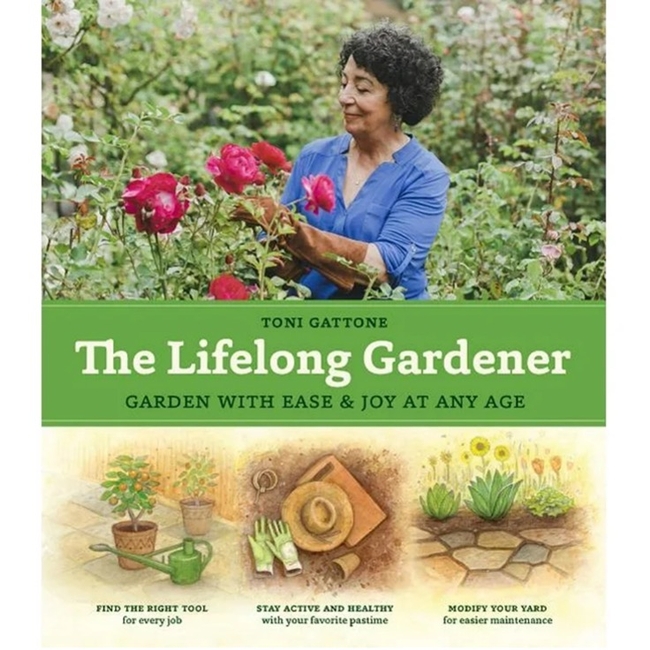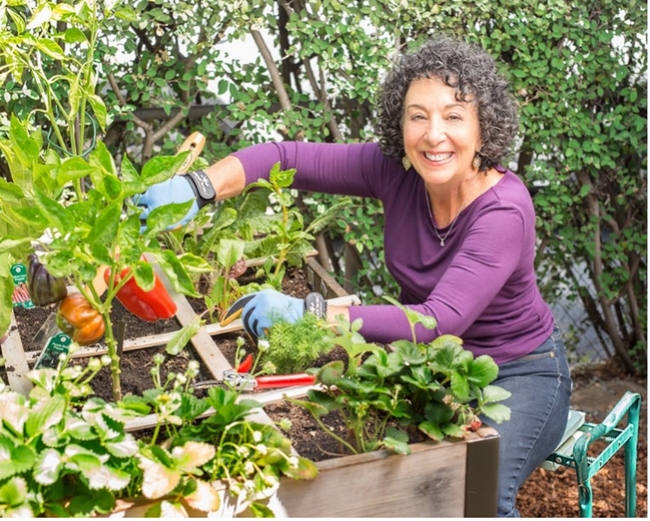The Lifelong Gardener, by Toni Gattone, offers lots of practical information on gardening as we age. The author is retired from the garden manufacturing industry with four decades of experience. She is also a certified UC Master Gardener in Marin County, CA, with 15 years' experience and one “bad back.”
The Lifelong Gardener is organized into three sections: 1) Your Body, 2) Your Garden, and 3) Your Tools. The book is quite readable with many photos, graphs, checklists, and illustrations. It is sprinkled with insightful adages from the likes of Dalai Lama, Mark Twain and Oliver Wendell Holmes.
Part I: Your Body contains many memorable quotes. Among them are: “Old is how you feel rather than your age” (p. 25), “Life is not about how long you live but how well” (p. 23), “We change our attitude by changing our perspective” (p. 250), “A project done is better than a perfectly done project” (p. 28), and “Resilience is our ability to adapt/recover from setback” (p. 28).
The first step in gardening and growing older is needing to accept our age-related limitations. We have shorter periods of sustained energy (30 minutes max), balance can be an issue (beware of heights), arthritis affects many of us (try electric- or battery-powered tools), lower-back issues plague many (work in elevated beds when possible), and strength is lessened (delegate assistance with heavy objects). Other issues include mobility, reaction time, compromised vision, temperature sensitivity, and thin skin bruising (senile purpura).
Seniors should do a bend and stretch warm-up for the benefit of muscles and joints prior to working in the garden. Gardening can implicate every muscle group as well as the joints in the spine, fingers, feet, neck, hips, knees, and legs.
Remember, repetitive motion invites stress injuries so frequently rotate the activity and the muscle group being used. For example, try a little pruning, followed by a little bending or squatting, next raking, some weeding, then sweeping, and finishing with potting plants and/or seedlings. The upside of daily physical activity in a garden is that it can reduce stroke, heart attack, and death by 28%.
Part II: Your Garden notes that a garden's layout or design may need modification. Plant selection should favor succulents, long-blooming shrubs and flowers, and pest- and drought-resistant cultivars. Consider plant longevity in the selections (fewer annuals, and more biennials and perennials). Design with your hydrozone in mind, grouping plants with similar needs for water, sun, and soil. Group pollinator plants in threes.
Consider grasses, which are both colorful and hardy. Herbs (parsley, rosemary, marjoram, basil, mint, sage, and thyme) provide a flavorful practical complement. They are characterized by low maintenance, yet are tolerant of poor soil, and some are drought resistant. Edible flowers such as cornflower, nasturtium, hibiscus, honeysuckle, pansy, and cape jasmine add brightness to the garden as well as the table. Bulbs are perennial and low maintenance. A short, thick groundcover can help block weed proliferation. The Sunset Western Garden Book is a credible reference for many types of plants and their needs.
Here are some types of gardening to consider as the transition to a more manageable garden is taking place:
- Container gardening. Its benefits include accessibility, lessened discomfort, easy maintenance (water and weeds), and fewer insect problems. Containers can be durable: ceramic, galvanized, fiberglass resin, terra cotta, cages, baskets, or even a wooden wine barrel.
- Raised bed gardening. A waist-high bed is more manageable, easier to water, and easier to control for weeds and pests.
- Vertical gardening. Some people downsize their place of residence with age. In adjusting to this new reality, consider a trellis, fence, wall, railing planter, balcony deck, window box, pergola, or arbor. Any of these could be part of a solution to surrendering our horizontal space.
Part III: Your Tools or Gear notes that protective eyewear or sunglasses, long sleeves, long pants, and a broad-brimmed hat are essential gardening apparel for everyone, not just senior gardeners. The right tools are needed for each and every task to accommodate for physical well-being and comfort issues or limitations that result from aging. There are many online and printed resources that evaluate and recommend various gardening accommodations and adjustments for the older gardener. Items approved and suggested are ergonomically designed for stress reduction. A partial list of instrumental accoutrement includes:
- Portable garden seat with a detachable tool bag
- Plastic watering can that is both lightweight and balanced
- Good tool sharpener with a comfort grip
- Retractable hose
- Kneeler that reverses to a seat
- Comfortable knee pads
- Stand-up weeder and/or a cobra head weeder/cultivator with an ergonomic grip
- Expandable (7- to 21-inch) tined rake with a telescopic handle
- Reusable debris bag that can be easily lifted when full
- Multifunctional trowel
- Good-quality, double-stitched gloves with reinforced fingertips and (if possible) padded palms that are light, washable, and durable. Gauntlet gloves that extend from the hand up the arm to protect the wrist and forearm are nice to have if there are thorny bushes in the landscape.
In summary, to be a successful lifelong gardener, use gentle stretches and mindful work to help care for the body, take a careful look at the garden landscape and redesign however possible to make upkeep easier, and use the right tools to make the job less stressful on both mind and body.


